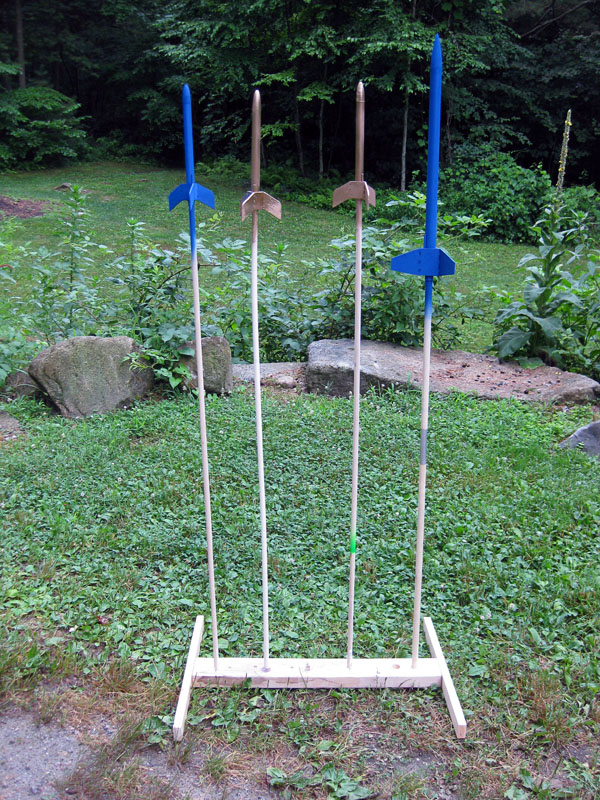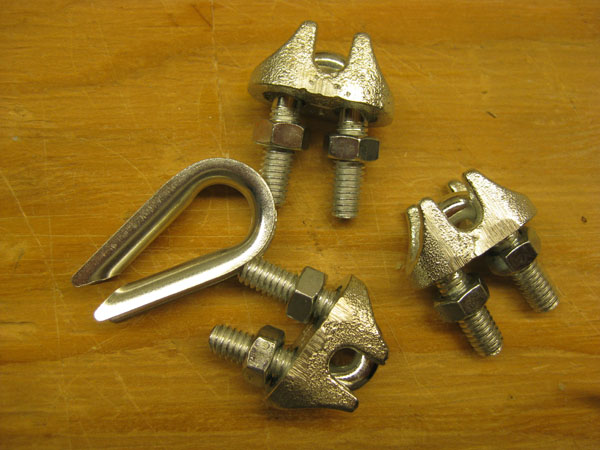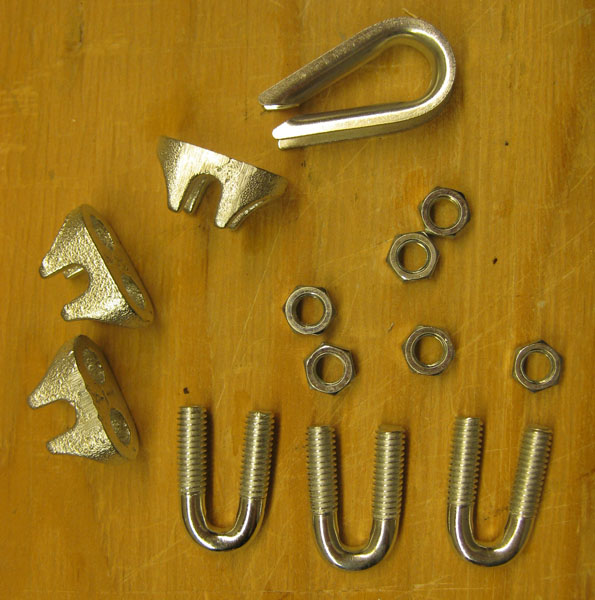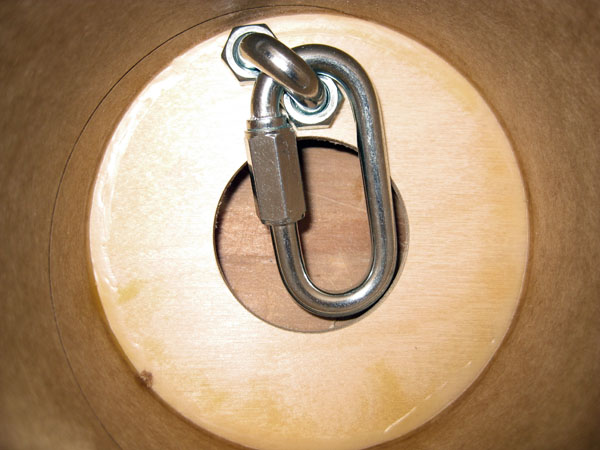Posted in Kid's Rockets on July 18th, 2010 by cpeds – Be the first to comment
Yesterday was a good day out with the kids. All four kids launched rockets multiple times. Miranda and her friends were launching their Whatchamacallits plus Miranda also launched her Giggle Powered once. Matthew launched his “Steam Fly” Thing-a-ma-Jig a few times but didn’t choose to launch Amazon this time around.
It was very hot so we didn’t stay there all afternoon, but we all enjoyed the day very much.
Trying to watch all of the rockets at once I didn’t have much time for shooting photographs or videos, but I did get this video of Matthew’s Steam Fly launching on a C6-5.
And here it is again in 1/8 speed slow motion (I love this new video camera)…
Posted in Product Reviews on July 18th, 2010 by cpeds – Be the first to comment
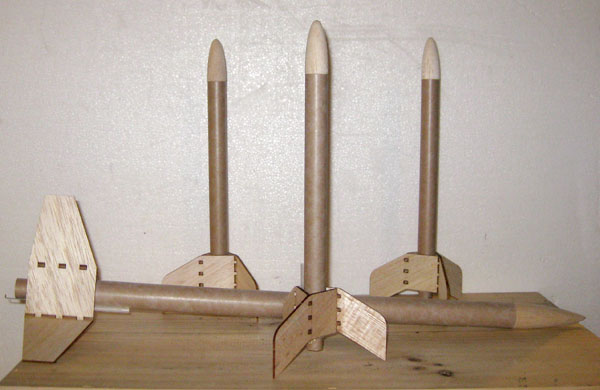
[The three small rockets are Whatchamacallits. The larger rocket is the
Thing-a-ma-Jig.]
The Whatchamacallit is a cool, small, skill level 1 rocket buildable by just about anyone. Three eight year old girls built these at our first rocket building party. It went very well. The only real catch was that some of the centering rings didn’t fit. I was able to correct that by removing a layer on the inside and/or outside. That did detract a little since I didn’t check them before the party, but we still had a lot of fun and the rockets came out great.
I really like the fin design. They lock together in such a way that aligning them on the rocket is very simple and does not require any sort of jig. We just used a little tape to hold them together while the glue was drying.
These rockets have 18mm (BT-20) body tubes and 13mm (BT-5) motor mounts. They take the standard Estes mini engines such as the A3-4. They use streamers for recovery.
The girls launched their rockets at the CMASS launch in Amesbury. They enjoyed drag racing and the rockets flew well. I was really thinking that the shock cords were too short, but it turns out that they were fine. The combination of kevlar string and elastic must be just right. They were recovered safely with no damage on every launch.
I think this is a very nice, well designed, clever kit and great for the beginner. If you are going to give it to a young child I suggest you assemble the pieces once or twice by yourself first to make sure you understand how they go together and to make sure they fit.
Posted in Product Reviews on July 18th, 2010 by cpeds – Be the first to comment

[The larger rocket is the Thing-a-ma-Jig. The three small rockets are
Whatchamacallits.]
The Thing-a-ma-Jig is a nice, moderately sized, skill level 1 rocket from FlisKits. With my help my three (now four) year old son was able to build it. I really like the fin design. They lock together in such a way that aligning them on the rocket is very simple and does not require any sort of jig. We just used a little tape to hold them together while the glue was drying.
To make the kit a little easier for my son I replaced the parachute with a party streamer.
This rocket has a 24mm (BT-50) body tube and an 18mm (BT-20) motor mount. It flies on standard 18mm engines such as the B6-4 and C6-5. As I mentioned above, it includes a parachute as the recovery device.
Matthew launched this rocket at the CMASS launch in Amesbury. It flew very well on the B6-4 and C6-5 and it was recovered safely with no damage every time.
I think this is a very nice, well designed, clever kit and great for the beginner. If you are going to give it to a young child I suggest you assemble the pieces once or twice by yourself first to make sure you understand how they go together and to make sure they fit. On the similar Whatchamacallit kits I’ve found several centering rings that did not fit properly. I got them to fit by removing a layer on the inside and/or the outside, but it is better to have everything just right before your child attempts to assemble it themselves.
This is a video of the Thing-a-ma-Jig flying on an Estes C6-5.
And here it is again in slow motion (I love this new video camera)…
Posted in Estes Nova Payloader on July 17th, 2010 by cpeds – Be the first to comment
I finished the modified Estes Nova Payloader just in the nick of time. It is sitting in the trunk of my car ready to be flown at the launch today. It is kind of slapped together, but it’ll do. Naturally I couldn’t stick with the original color scheme. Hopefully it will be a calm day and I’ll return with some good video.
UPDATE: It wasn’t a calm day. The kids had fun launching their rockets, but it was too windy for this one.

Posted in Product Reviews on July 16th, 2010 by cpeds – Be the first to comment
[Disclaimer: I am an affiliate of
Amazon.com. I may receive a commission if you purchase this set via one of the links on this page.]
My kids had a blast building and flying the rockets from the Estes Tandem X Rocket Launch Set.
Matthew, who was three years old at the time, built the skill level “E2X” (easier than skill level 1), nearly three feet long Amazon and it was plenty easy enough for him with my help. The fin can is plastic and the fins snap in so you don’t have to worry about alignment or jigs. We replaced the parachute with a party streamer and that worked well. He did not keep it the original black but instead painted it green and covered it with stickers. He flew it six times on C6-5 motors at the first launch without any issues at all.
The C6-5 provides enough power to get the rocket up high enough, but the rocket is fairly large and heavy so it is nice and slow. There is something to be said for a rocket you can track with your eye and camera. I really enjoy a slow, majestic launch.
Miranda who was eight years old at the time built the more complex Crossfire ISX. This is a skill level 1 kit and she was able to build it with my help. We replaced the parachute with a party streamer. Unfortunately, we also used a shock cord I had laying around that turned out to be too short. It broke during the first four launches, but the rocket did not suffer any damage despite falling without any form of recovery system. It’s pretty sturdy. Once we put in a longer shock cord it worked fine. Miranda did not use the original white and red color scheme or original decals. Instead she painted it dark blue and covered it in smiley face stickers. She named it “Giggle Powered”.
Giggle Powered flew six times at that first launch on B4-4 motors. Despite using the smaller motors her small Crossfire ISX was much faster than Matthew’s larger Amazon. It was plenty fast and high enough. Although it can take C6-5 motors, you should only use them if you have access to a very large field.
The launch pad and controller are cheap but work fine. No complaints there, but I’ll probably never use them.
All in all I was quite pleased with this kit. Everything worked well.
Posted in Estes Nova Payloader on July 13th, 2010 by cpeds – Be the first to comment
Since I am not going to finish Project Overkill in time for Saturday’s launch I decided to slap together a modified Estes Nova Payloader tonight. That’ll allow me to still fly the Muvi video camera.
The modifications I made were fairly minor, but being me I just can’t seem to build a kit as is. First, I made the payload section a pass through so the parachute will come up through the payload section instead of separating the rocket at the bottom of the payload section. Â I did this so that the camera will be ejected and hang roughly right side up after the parachute deploys. Â Second, I used a different shock cord. Â I used a very long kevlar string and tied it to the engine mount between the centering rings instead of gluing it to the inside of the body tube. Â Third, I used two 1/4″ launch lugs instead of the one 1/8″ lug that came with the kit. Â That means that I’ll be able to use the longer, four foot launch rods. Â Since I used two launch lugs, I could put one down near the bottom of the rocket, just to give those few extra inches of flight time before leaving the rod. Â I want this rocket flying as fast as possible when it comes off the end of the launch rod since the camera is going to make it way over stable. Fourth, I used bent picture wire as an engine retaining device instead of the standard engine hook. That will allow me to use the longer Apogee D3 motors if it is a really calm day while still being able to use the shorter Estes C6 motors on a normal day.
Once the glue is dry I’ll paint it. Once that is dry I’ll glue the payload section to the body tube, tie the shock cord to the nose cone and camera, and attach the parachute. Then it’ll be done. I should be able to complete it in two sessions if I don’t worry too much about the paint job. This one is more about flying the new video camera than making a beautiful model.
Posted in Kid's Rockets on July 10th, 2010 by cpeds – Be the first to comment
Today the kids had a painting party with two of Miranda’s friends. They painted the rockets that they had built at their first rocket building party back in June.
We started by taking them to iParty to pick out stickers they’ll put on the rockets the day of the launch. Then we went to the hardware store and they picked out their spray paint. The trips from iParty to the hardware store and then back home were adventurous given that it was pouring out! We all got soaked. That did not bode well for the outdoor paint party, but a tarp on the garage floor solved the issue.
The rockets came out pretty well, especially given the kid’s ages (three of them are eight years old and one is four years old) and the fact that we did not do any sanding or priming.
TIP: As you can see in the photo, I like to put them at the end of a really long pole so that the kids don’t spray paint me when I’m holding the rockets. The poles can then rest in that little stand I whipped together while they dry. If you try this, make sure the poles can’t push the nosecone off. If the rocket has a thrust ring then using a pole wider than the opening in the thrust ring will work. Another option is to wrap a thick layer of tape around the pole to stop the rocket from sliding down it.
Posted in Project Overkill on July 7th, 2010 by cpeds – Be the first to comment
I’ll provide an update on the dual deployment system after one more test, probably tomorrow, but it looks like it works now!
After working on that today I decided to try out the parachute. I have never been successful with a parachute before so I wanted to make sure that I was folding it in a manner that would work. One time when I was a kid I tried a parachute without enough wadding and it melted. Since then I’ve focused on other types of recovery systems. Now I’m building a huge rocket that is going to rely on not one but two parachutes!
This first video is a super slow motion capture, about 1/16th normal speed (3.75fps versus 60fps), of the parachute unfolding. I folded it exactly the way I’m planning too in the rocket and threw it off my deck with a five pound weight attached to it. You can see that it finishes opening right as the weight hits the ground. It’s only fully open for one frame, but it clearly worked.
Having seen that the folding technique works, I wanted to see what this parachute would look like flying through the air fully open. This time I left it unfolded when I threw it. It looked very good floating quickly to the ground.
Here it is at full speed in case you want to see it. Just don’t blink…
Posted in Project Overkill on July 6th, 2010 by cpeds – Be the first to comment
I saw this article about building a dual deployment device without black powder and thought that would be perfect for Project Overkill.
I didn’t build it exactly as explained in that article, but close enough. After building it I put in an igniter and tied it together with fishing line. Then I grabbed the shock cord and shook it like crazy. I wanted to see how it would react. The fishing line broke off all the pyrogen from the igniter. Were this a real flight, the main would not have deployed. I need to think about this design and rework it.
One thing I’ve done since that test that may help is build a guide for the fishing line that extends right up to and across the break between the two halves of the container. I’ve also added a tab near the bottom of one of the halves to try to keep them aligned a little better. Finally, I added some screws to hold the fishing line instead of just tying it on the back side. I’ll give it a go tomorrow night and see how it works out. I can’t try it right now because the epoxy is still wet.
Posted in Project Overkill on July 4th, 2010 by cpeds – Be the first to comment
I read somewhere that if you are going to use an eye bolt for a shock cord mount in a high powered rocket you should use one that is welded shut. The person who wrote that article was claiming that the strain on the bolt can open the eye if it isn’t welded shut.
That seemed like a bit of overkill to me, but then again this is Project Overkill so… I definitely considered it. All of the sources I know about don’t have the type that is welded shut, but I came up with another idea. Take a look at these rope clamps.
If you take them apart they look like this.
If you take one of those U shaped bolts, four of the nuts, and add a couple of washers, I bet that’s pretty strong and probably over kill. So, that’s what I did.
You can’t see the washers, but I did put a couple on the bottom of the centering ring. I figure that’s where they are needed.
TIP: If you use a U bolt and quick release ring like this you may need to attach the ring before putting the U bolt into the centering ring. You may not have room to fiddle with the quick release ring after attaching the U bolt. If you do that, make sure that your quick release ring is positioned such that its opening angles away from the tube to give you the maximum space on that side, and make sure that the opening is as close to the top as possible. You may notice in this photo that although I got the opening on the correct side, I did not position it near the top. That will make it just a little bit harder to attach the shock cord later. I’d fix it, but I already put some epoxy clay on the bottom nuts to make sure they didn’t loosen. Once this is mounted in the rocket I will not be able to reach the bottom nuts to tighten them if they get loose.
 [The three small rockets are Whatchamacallits. The larger rocket is the
[The three small rockets are Whatchamacallits. The larger rocket is the 


